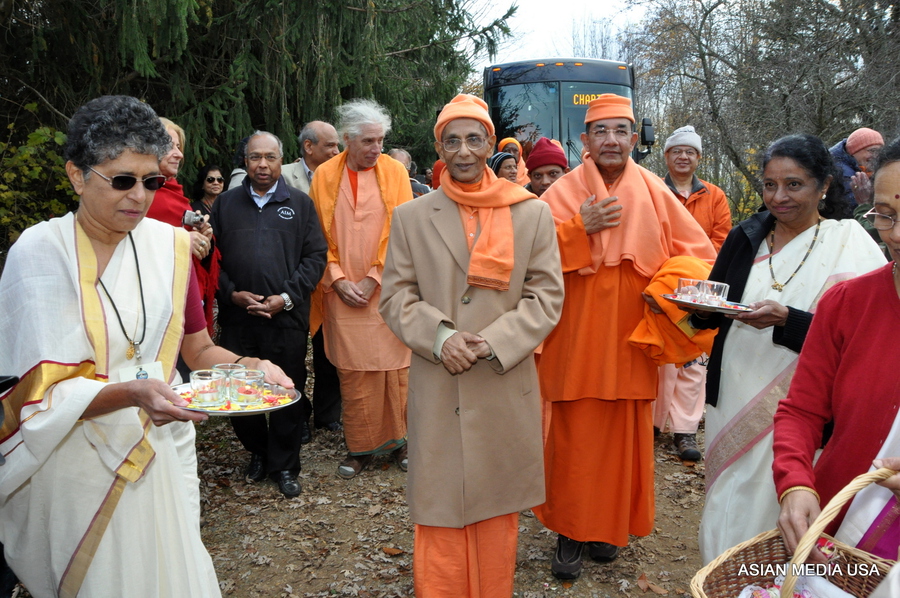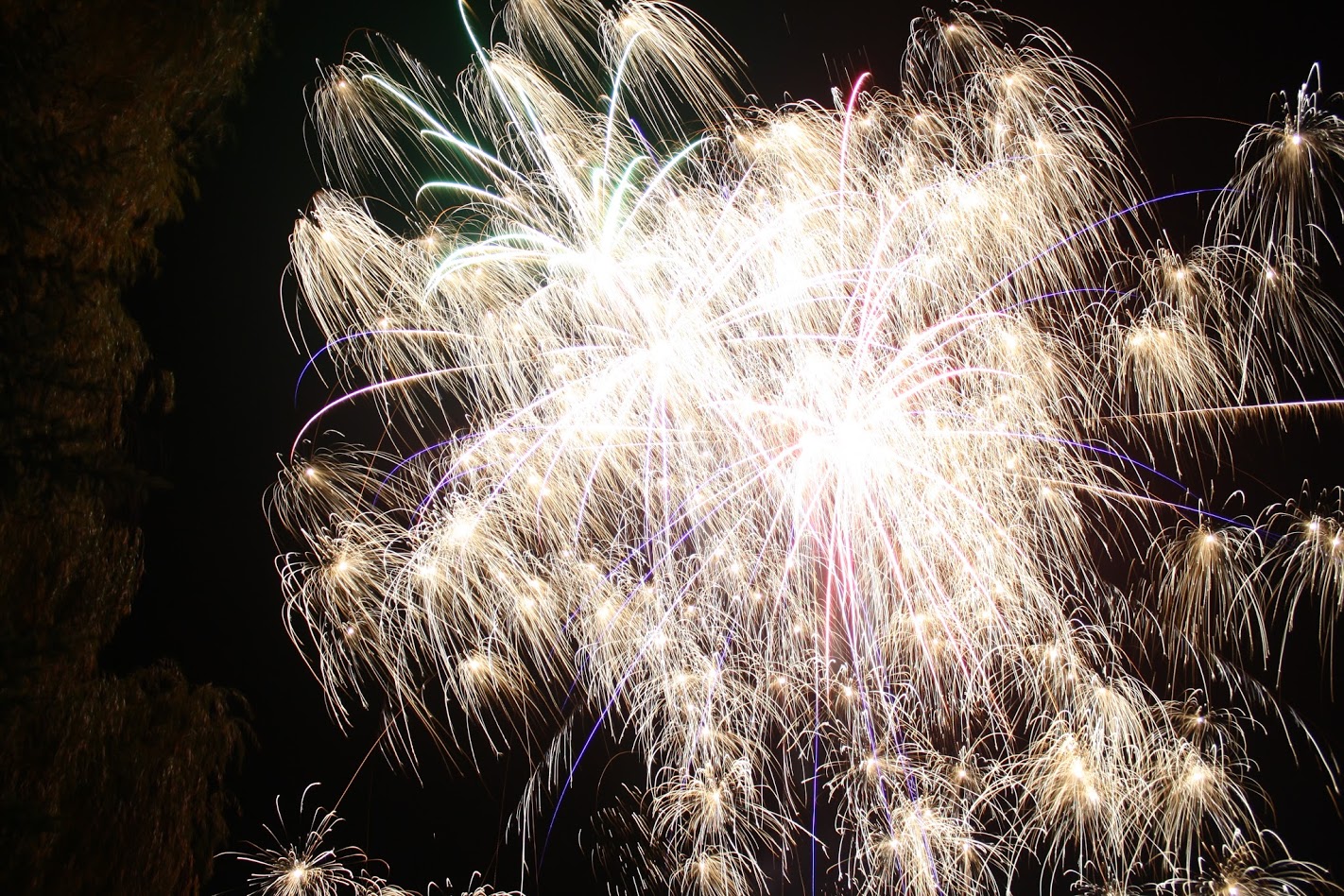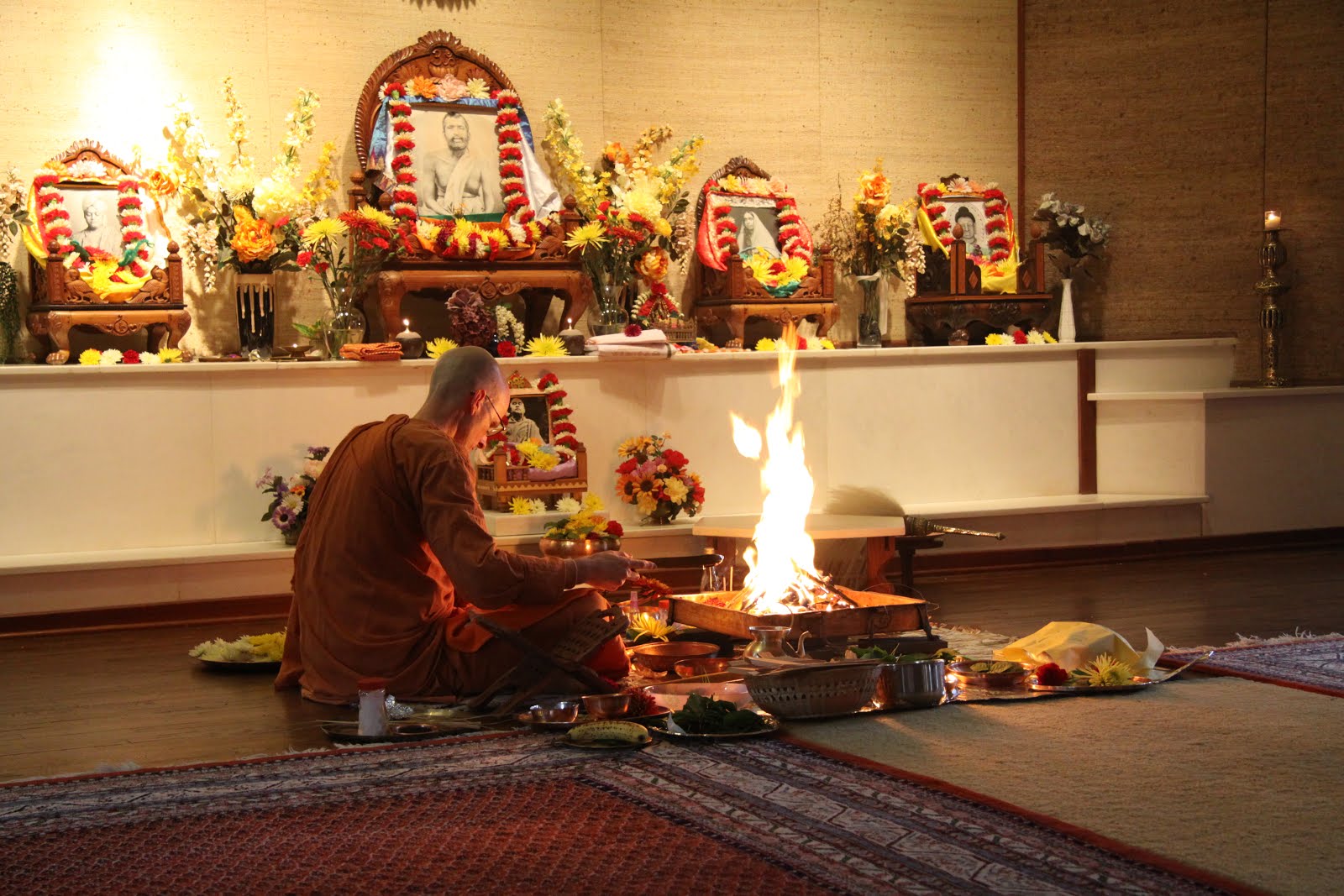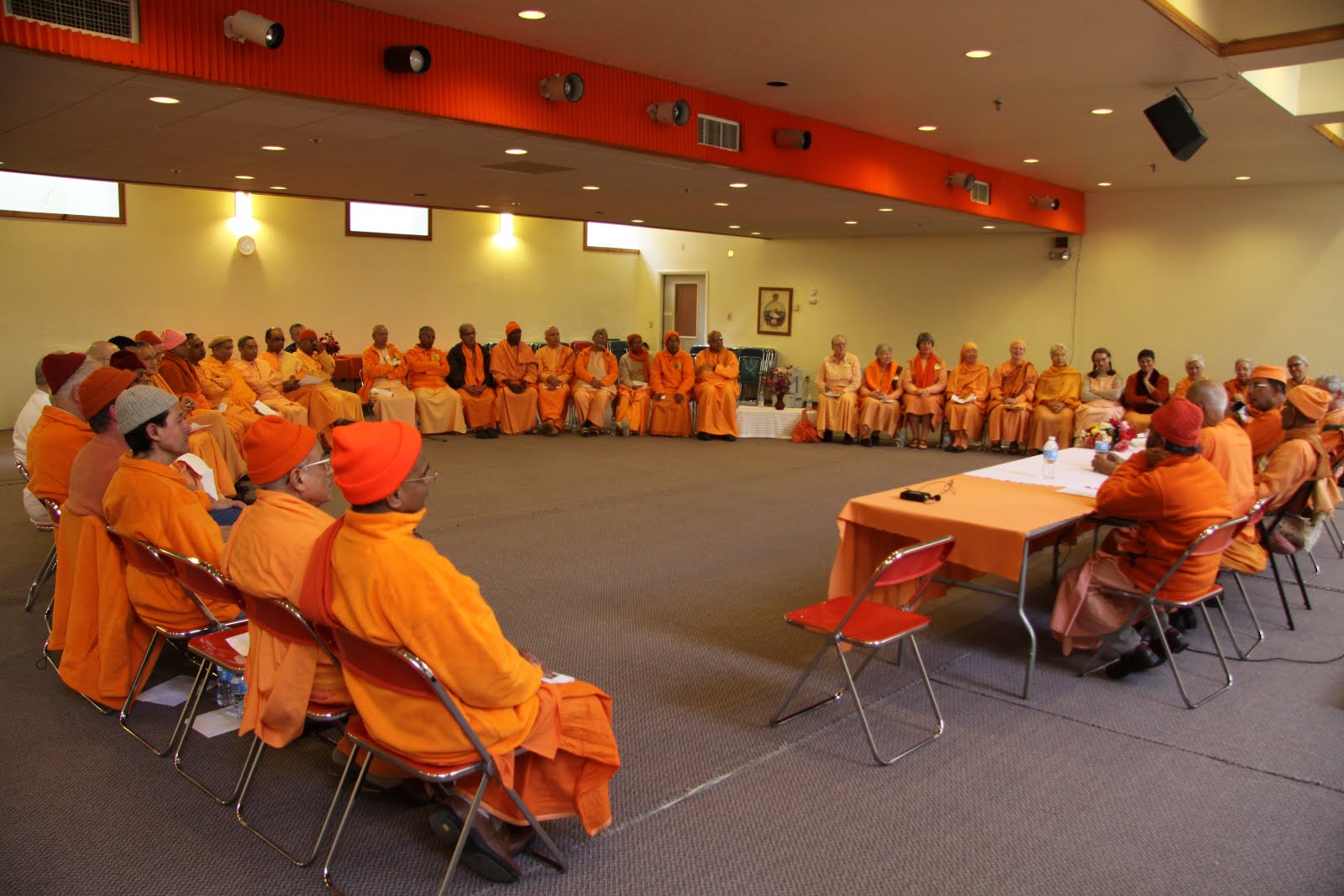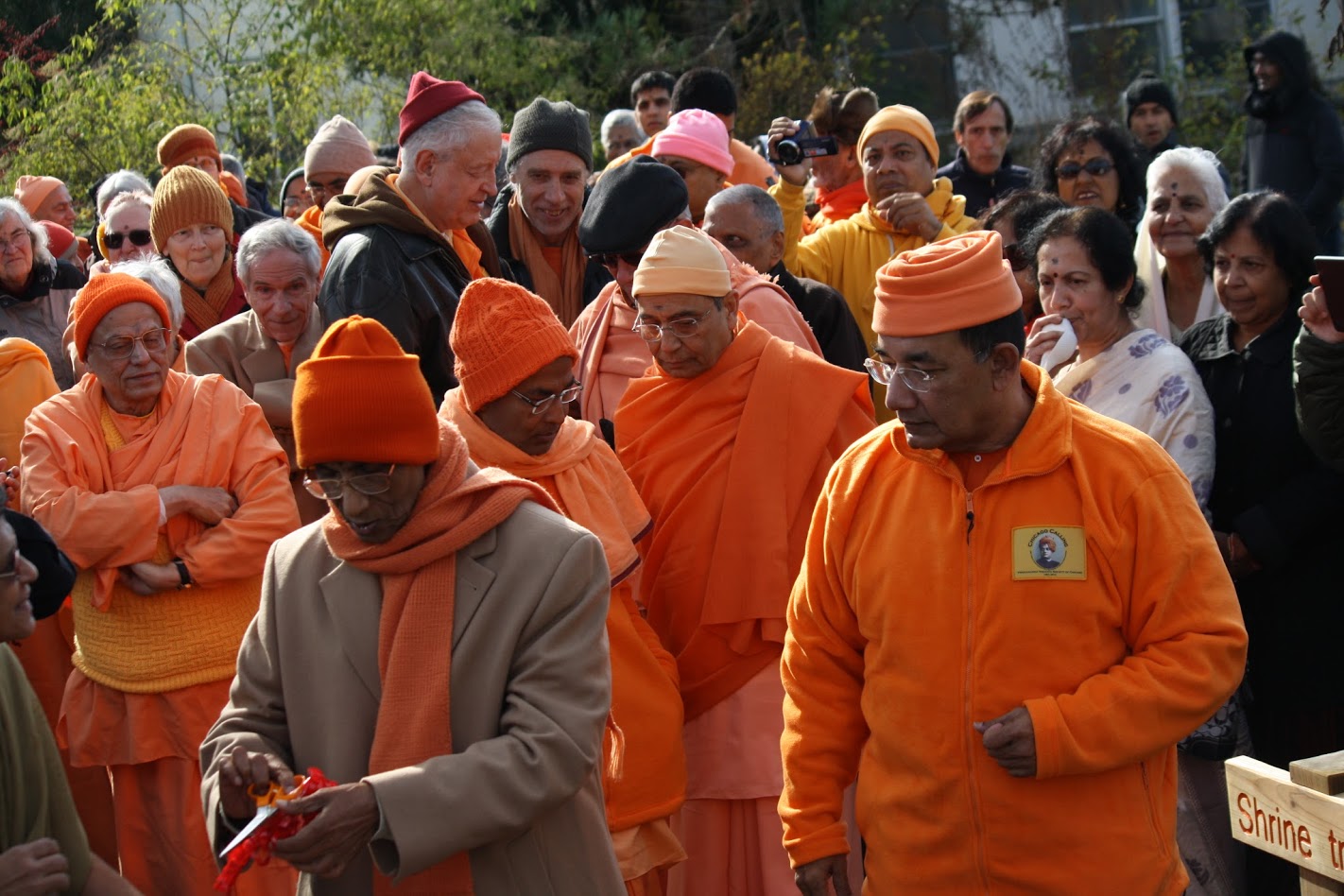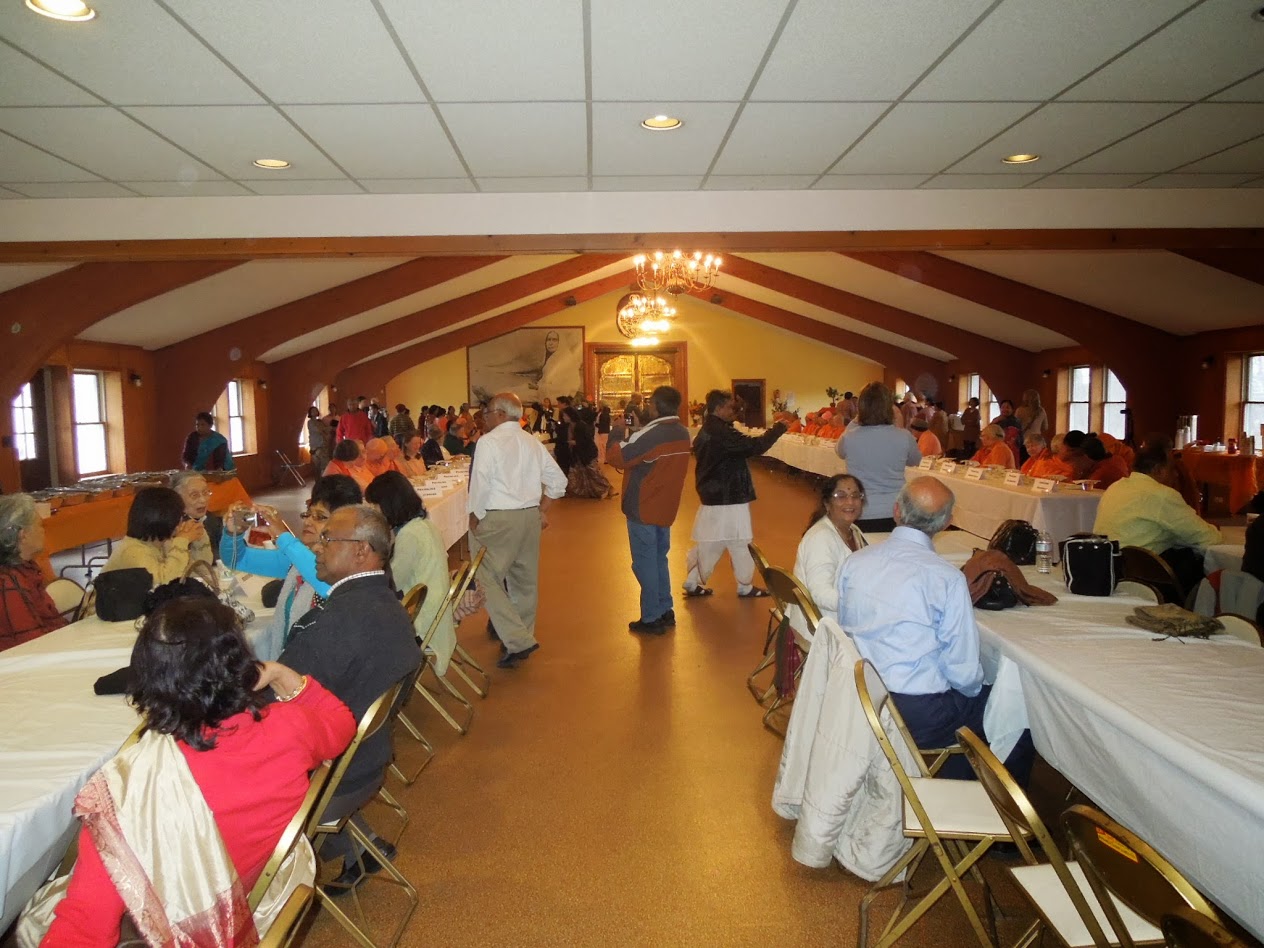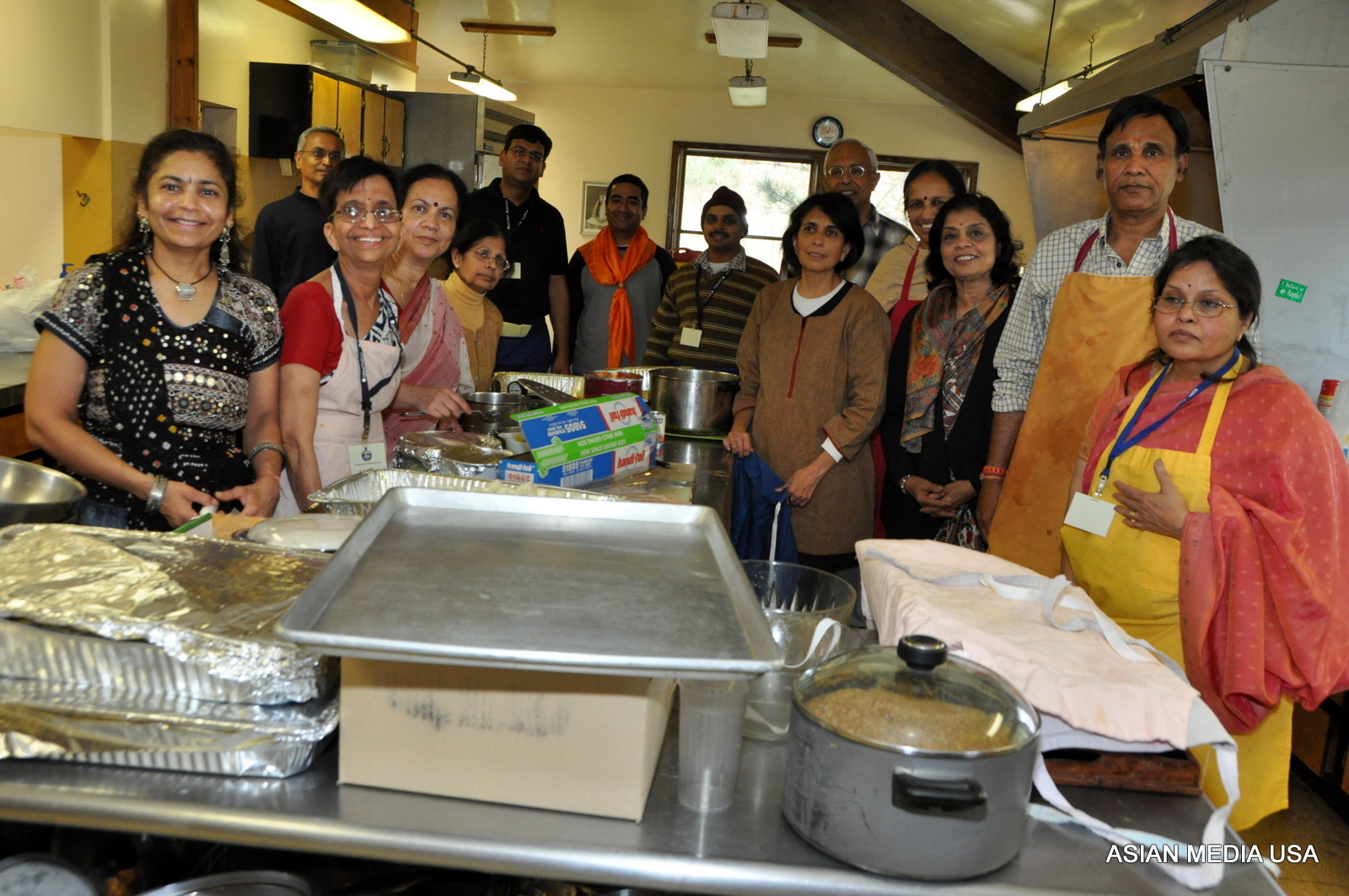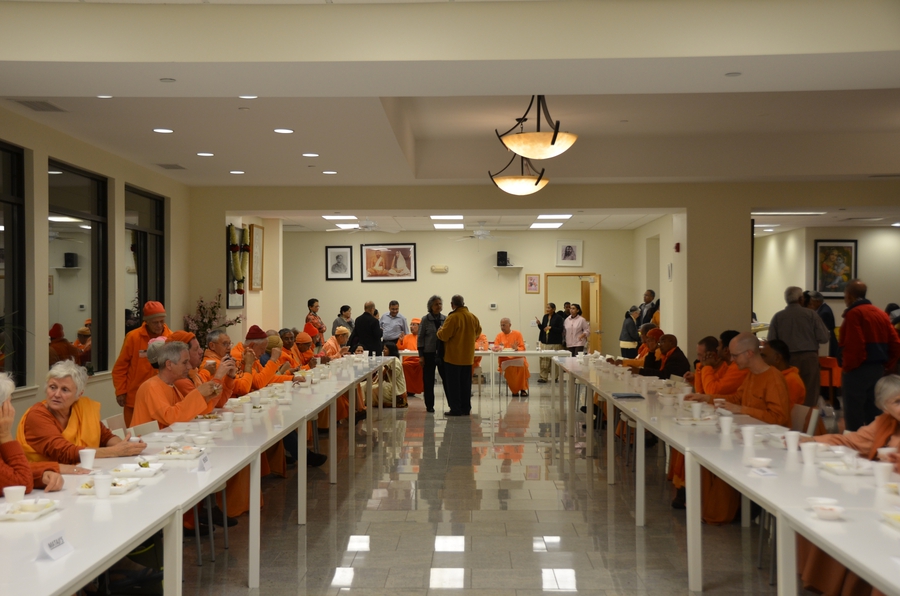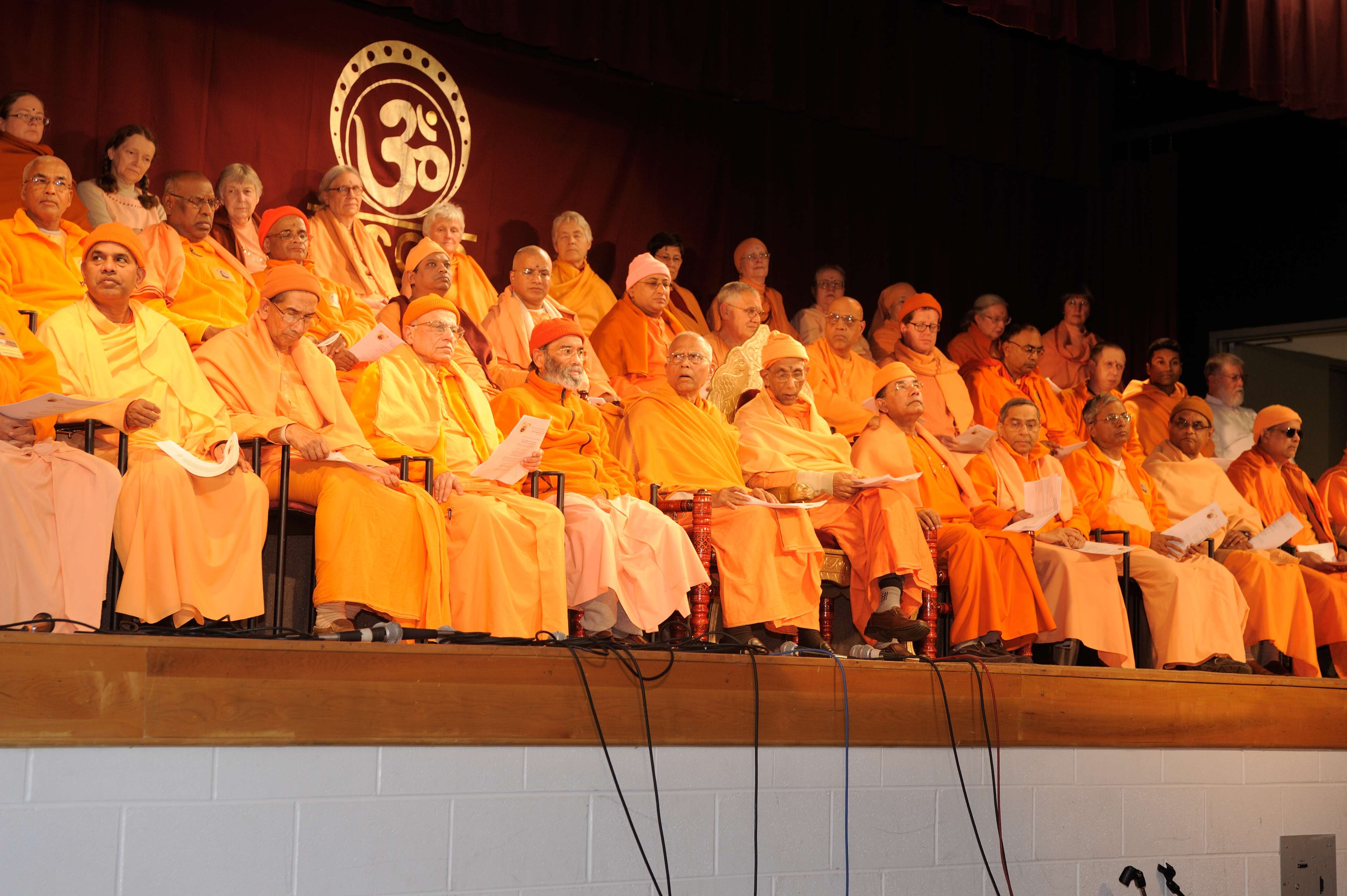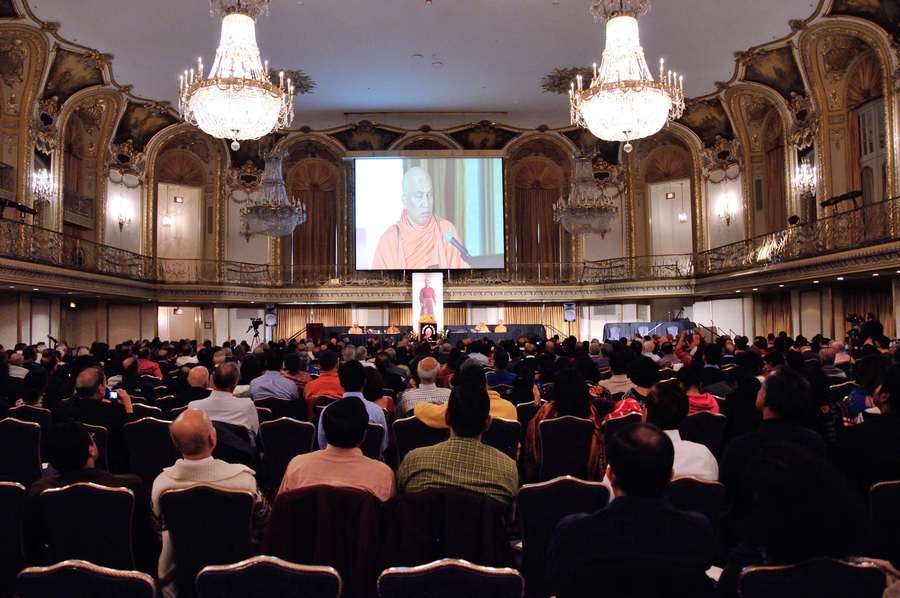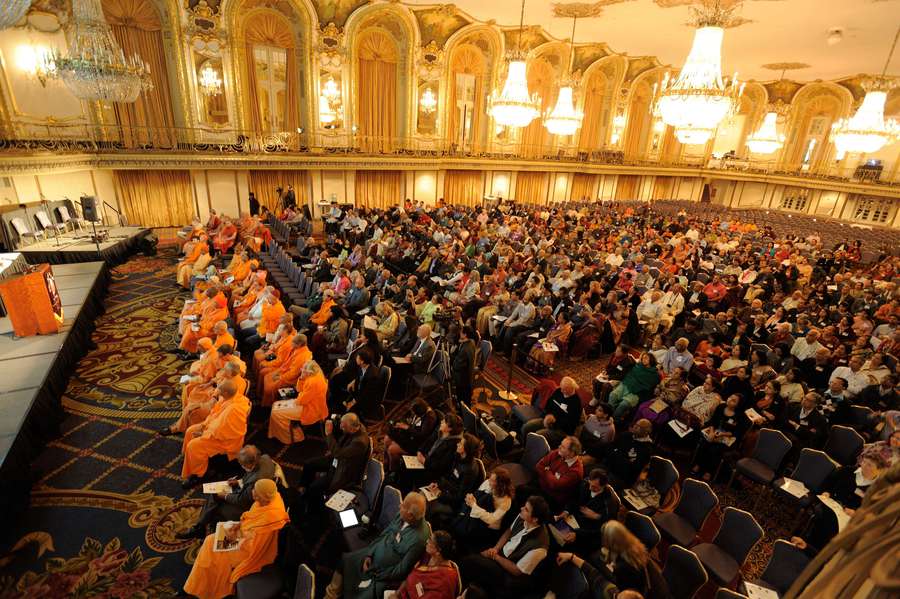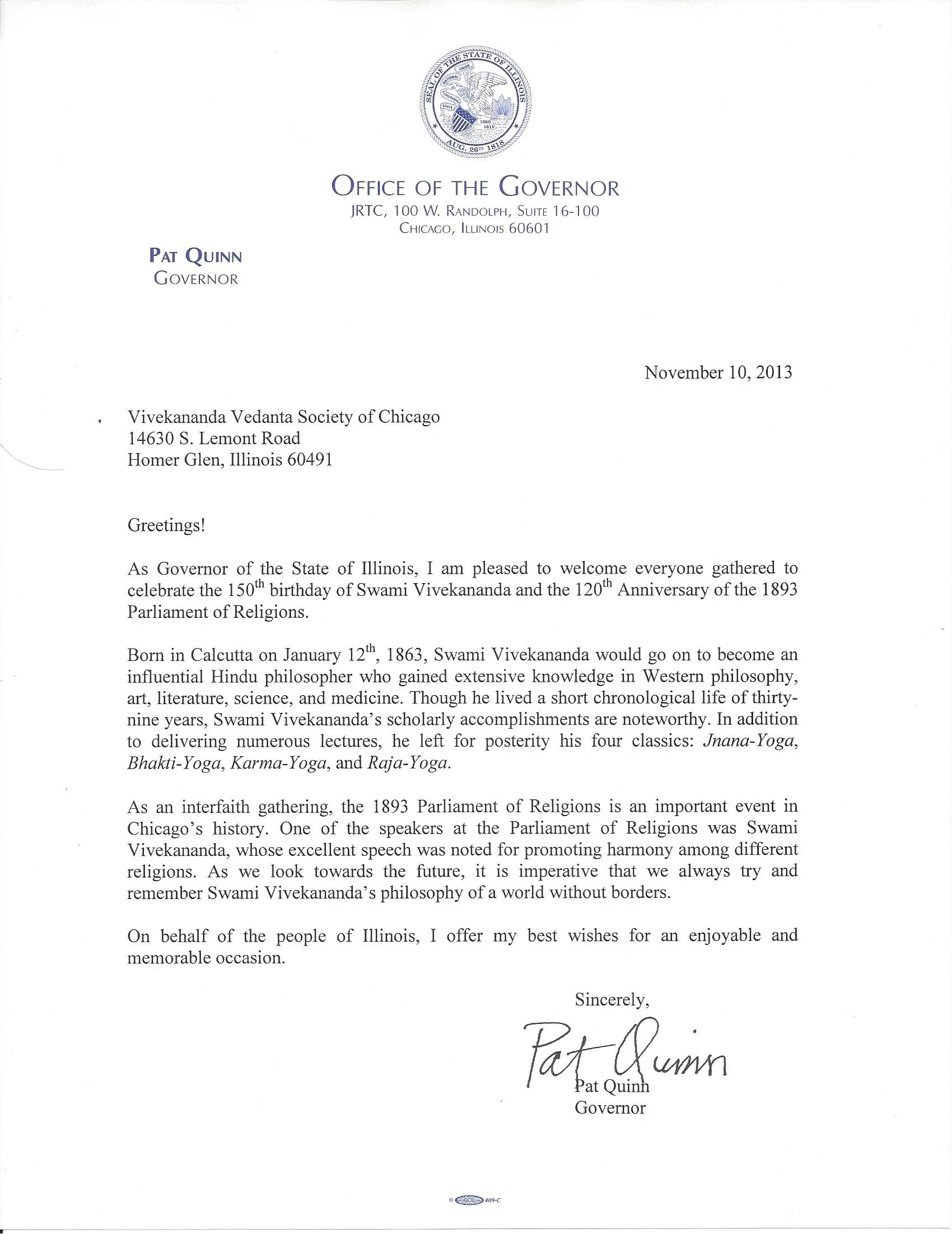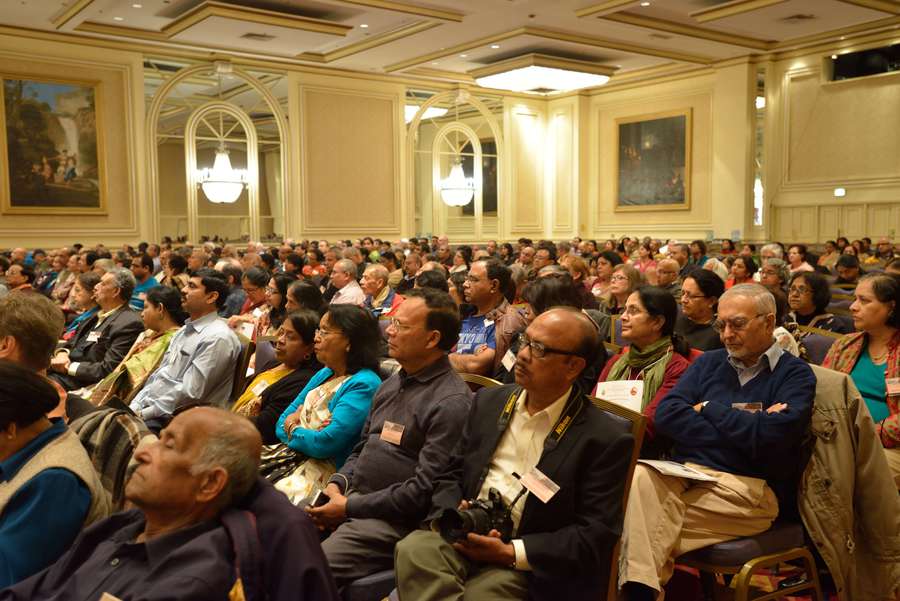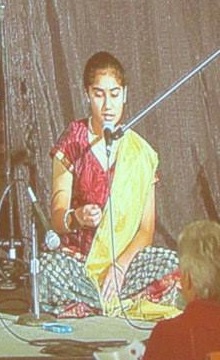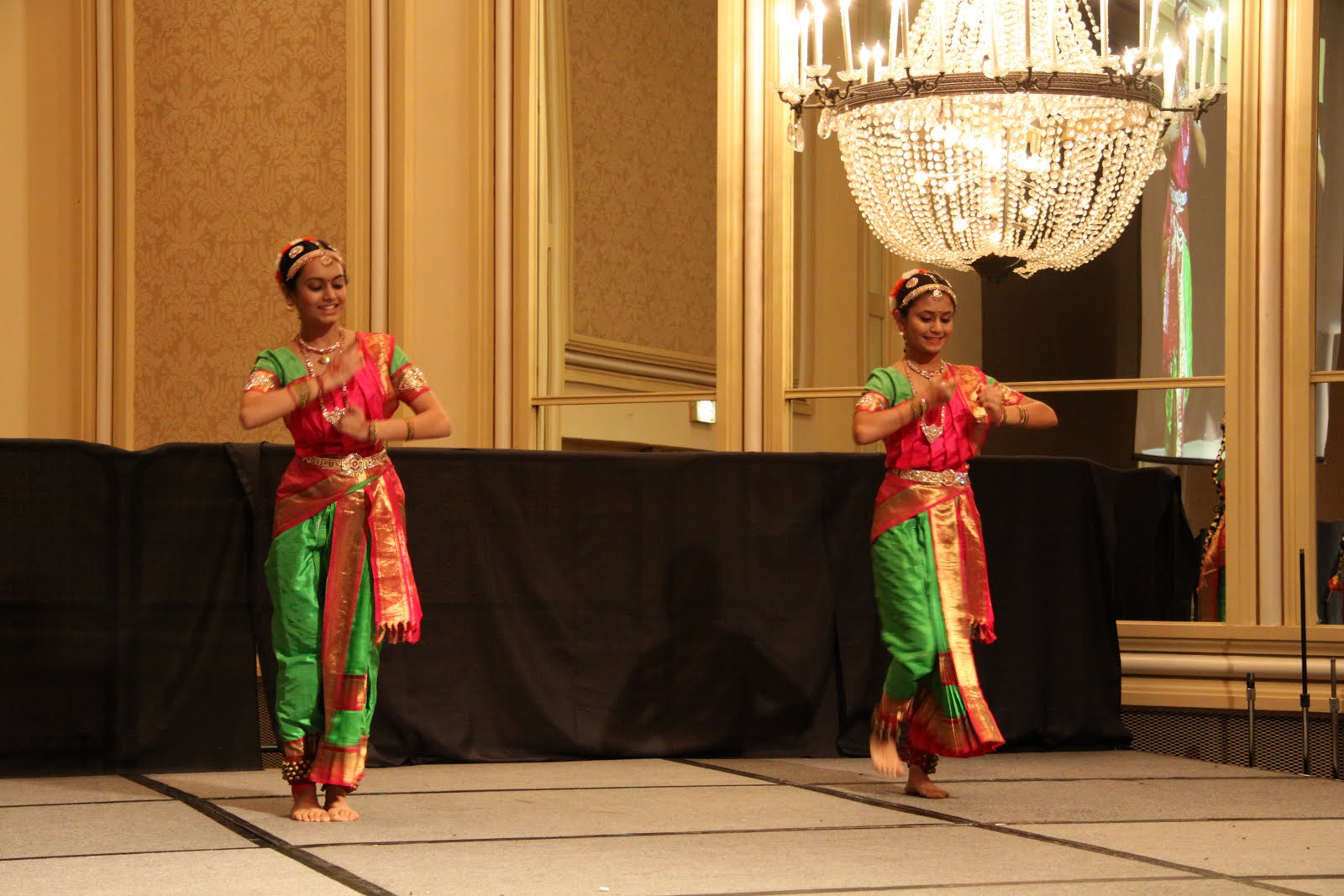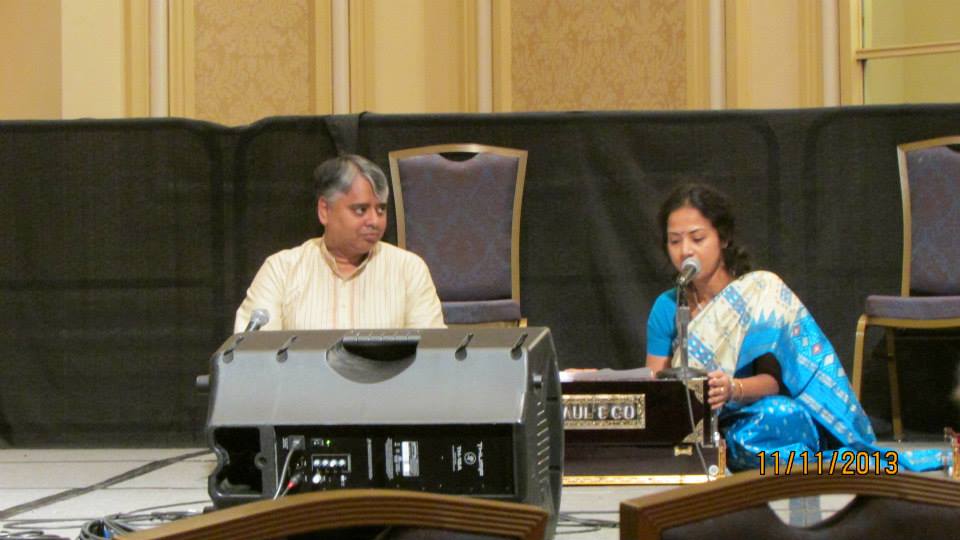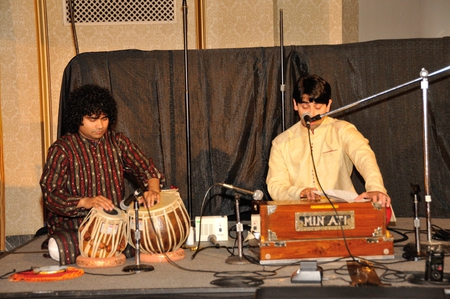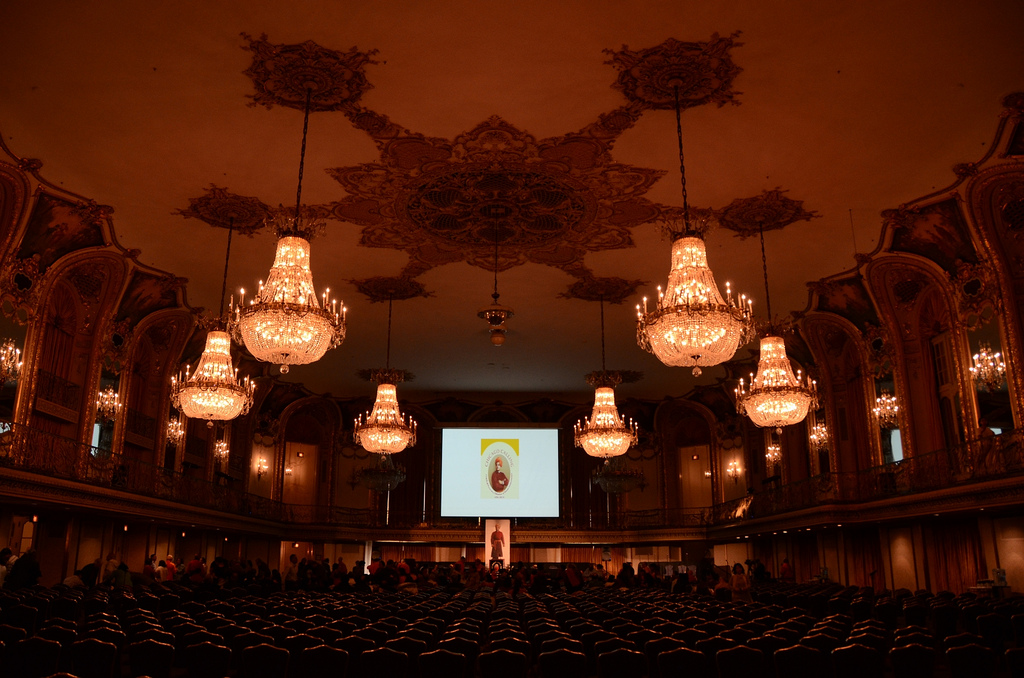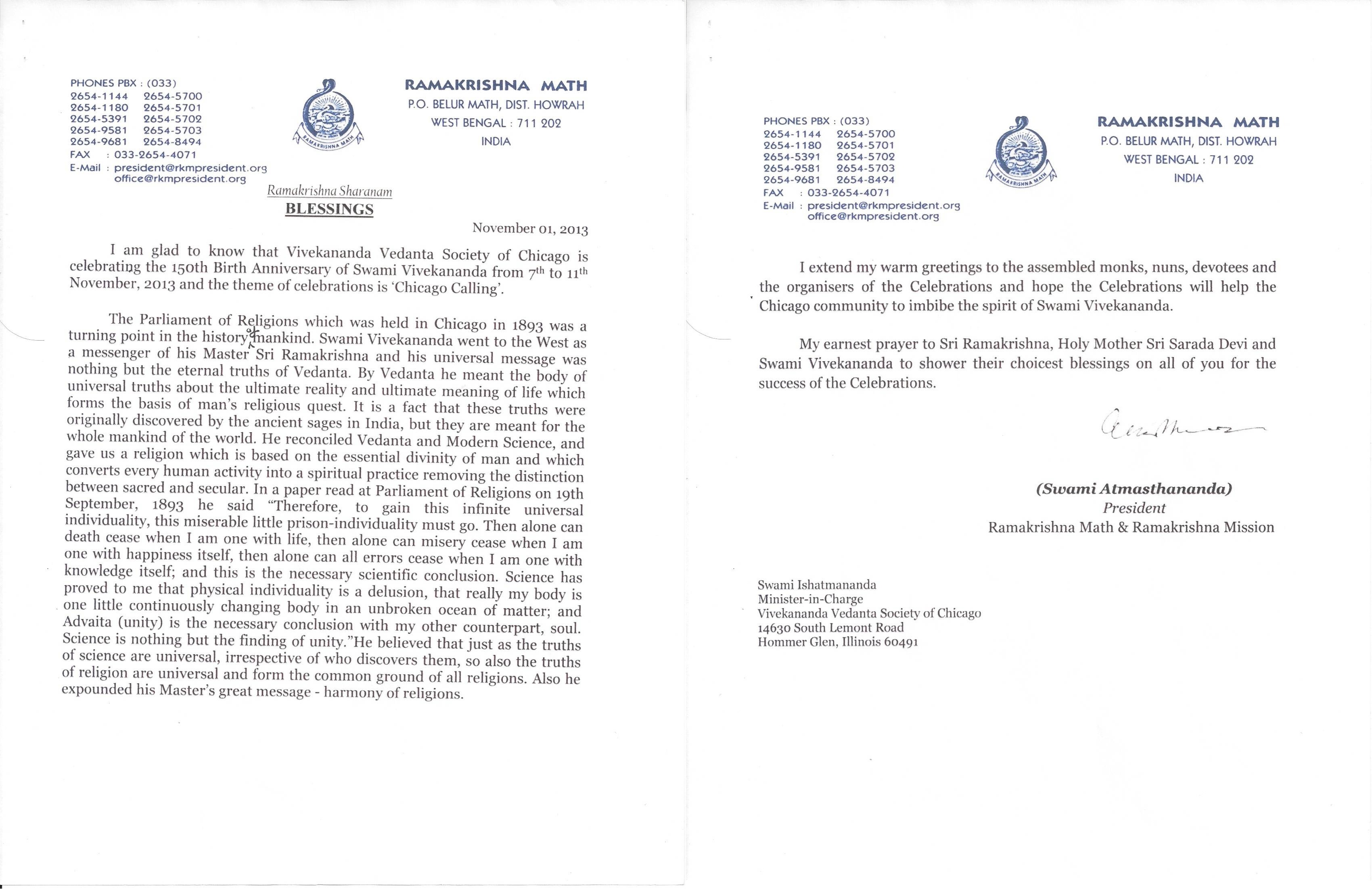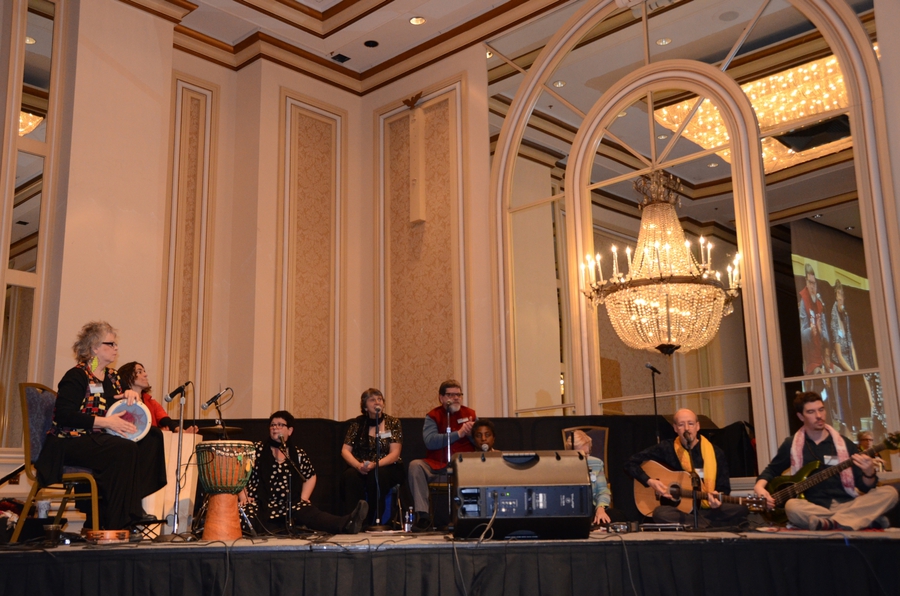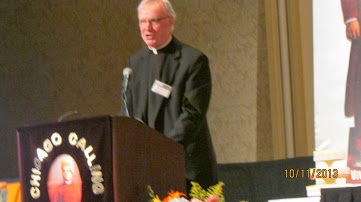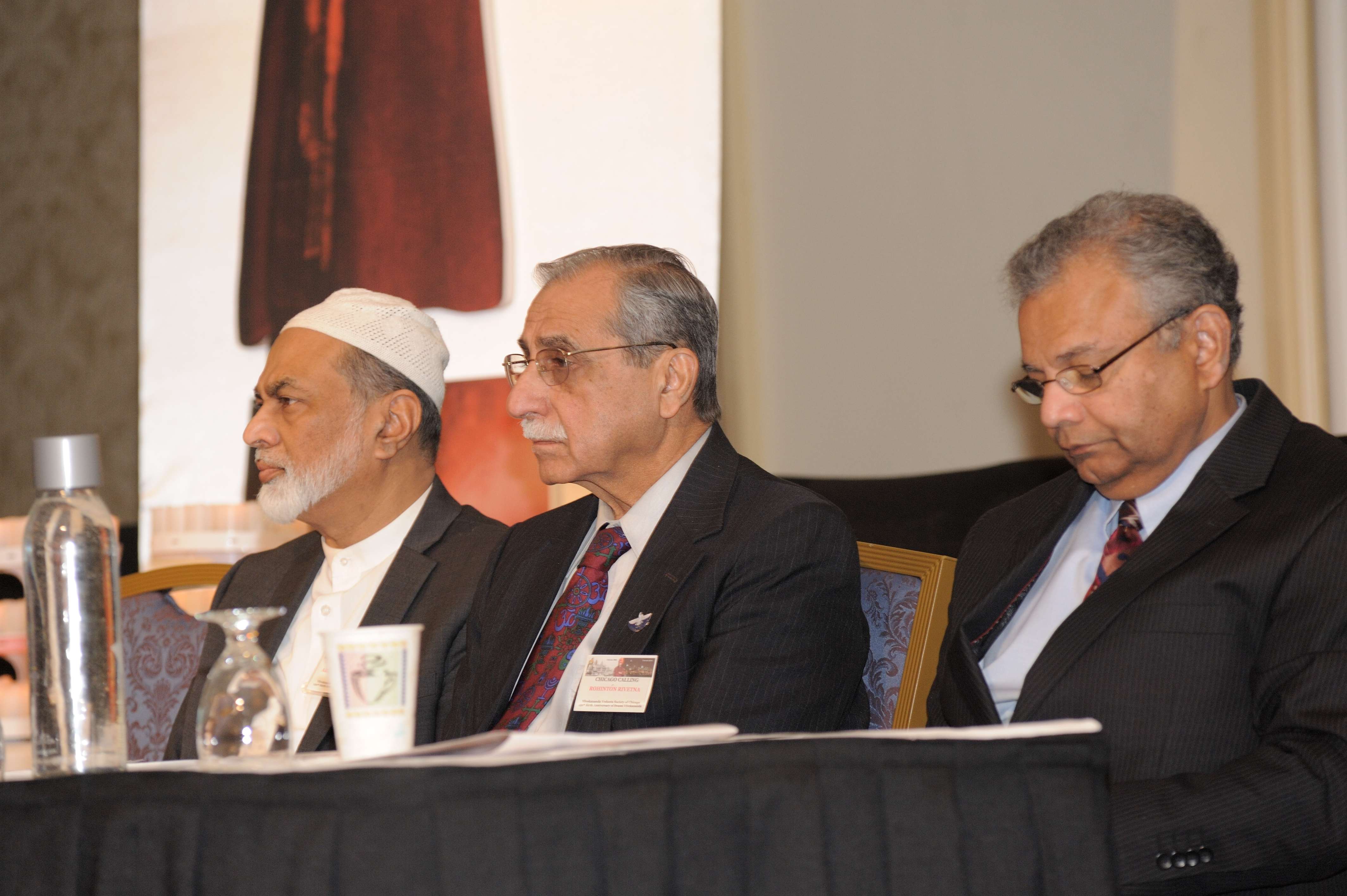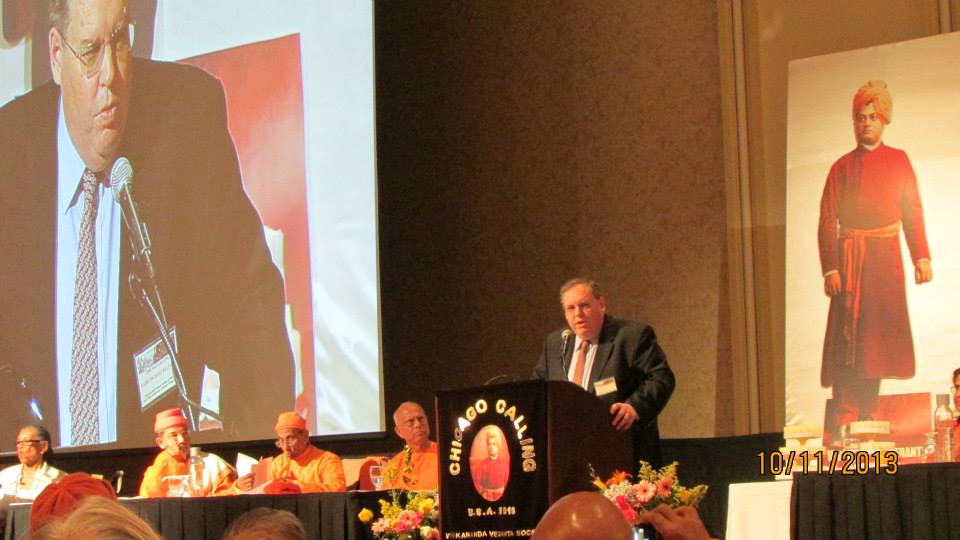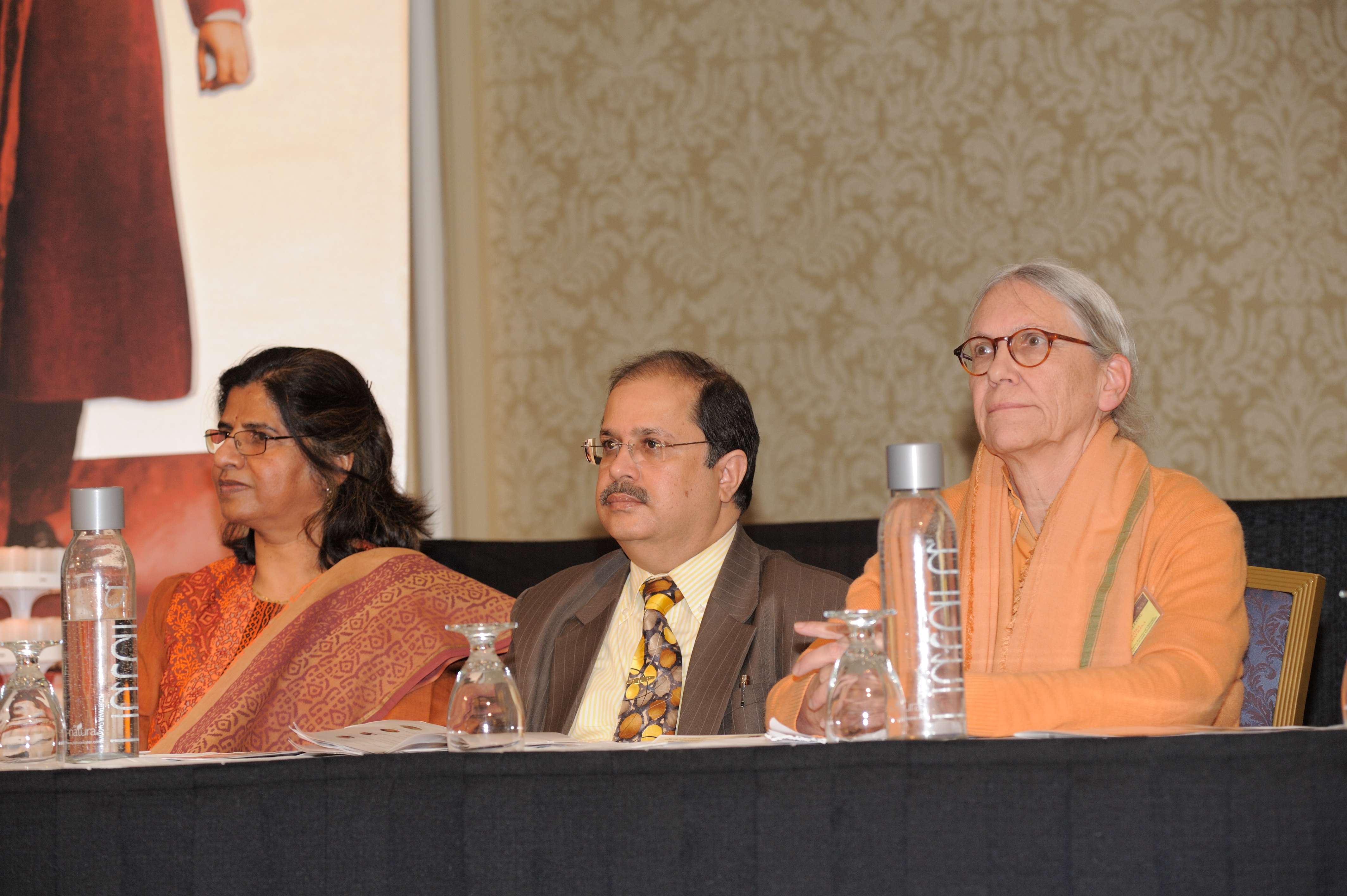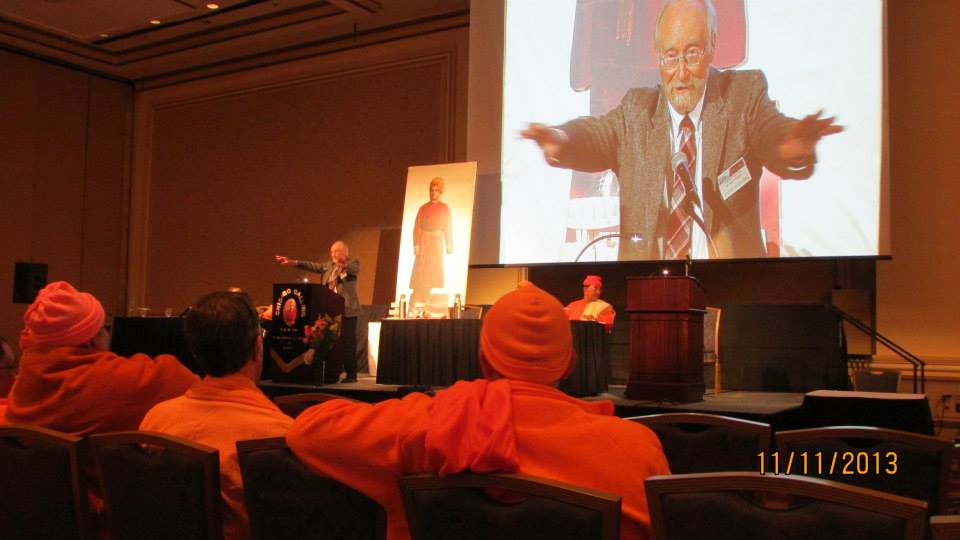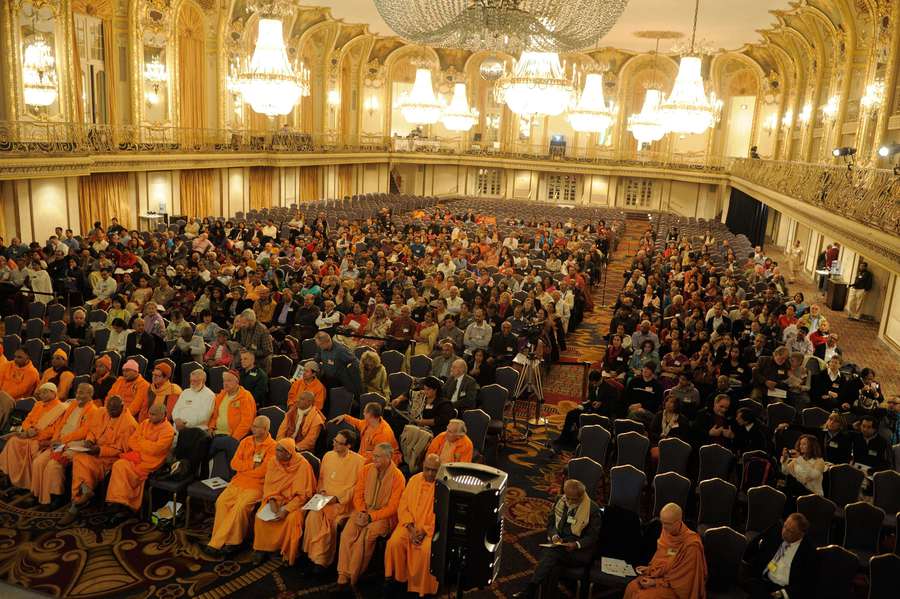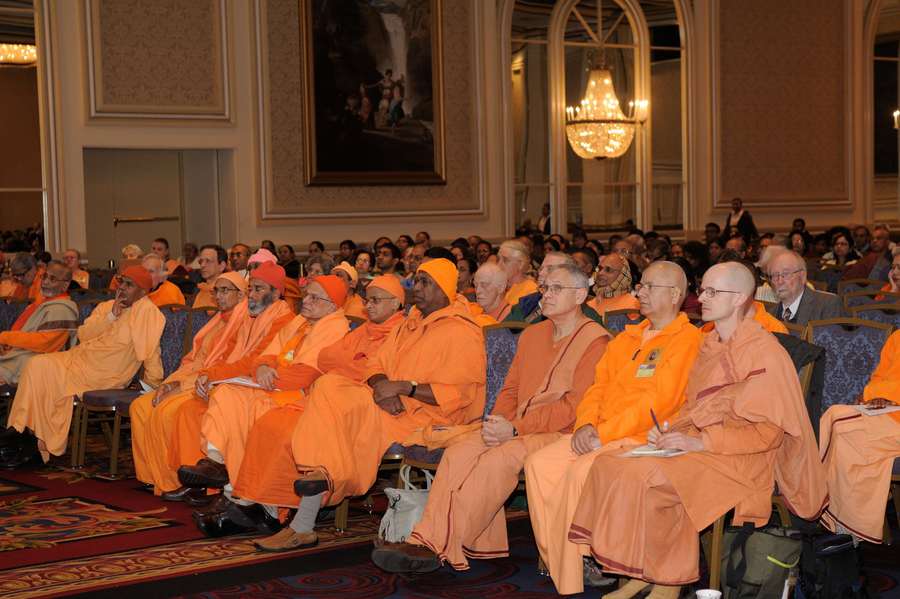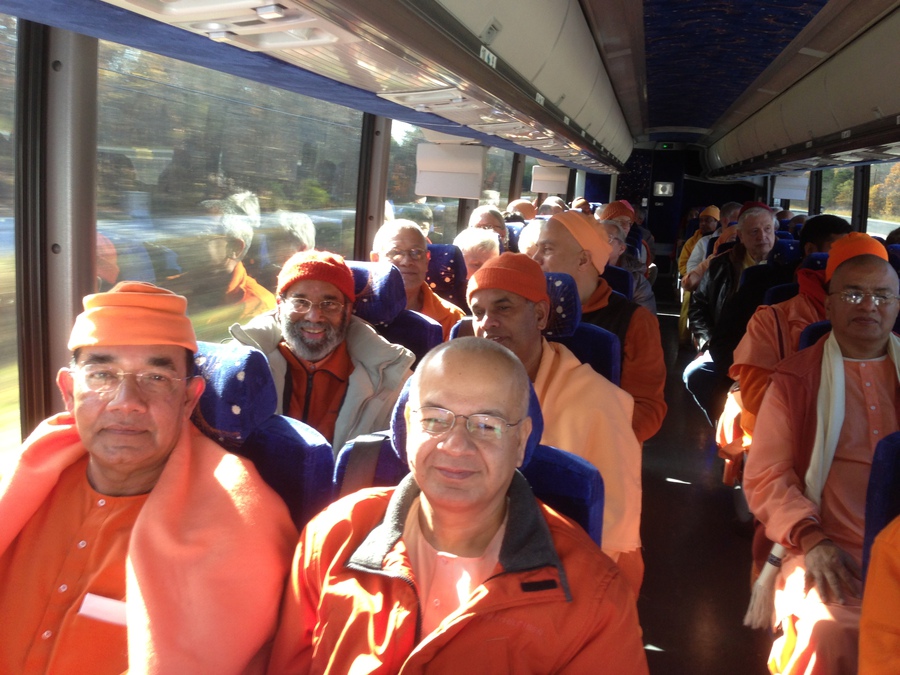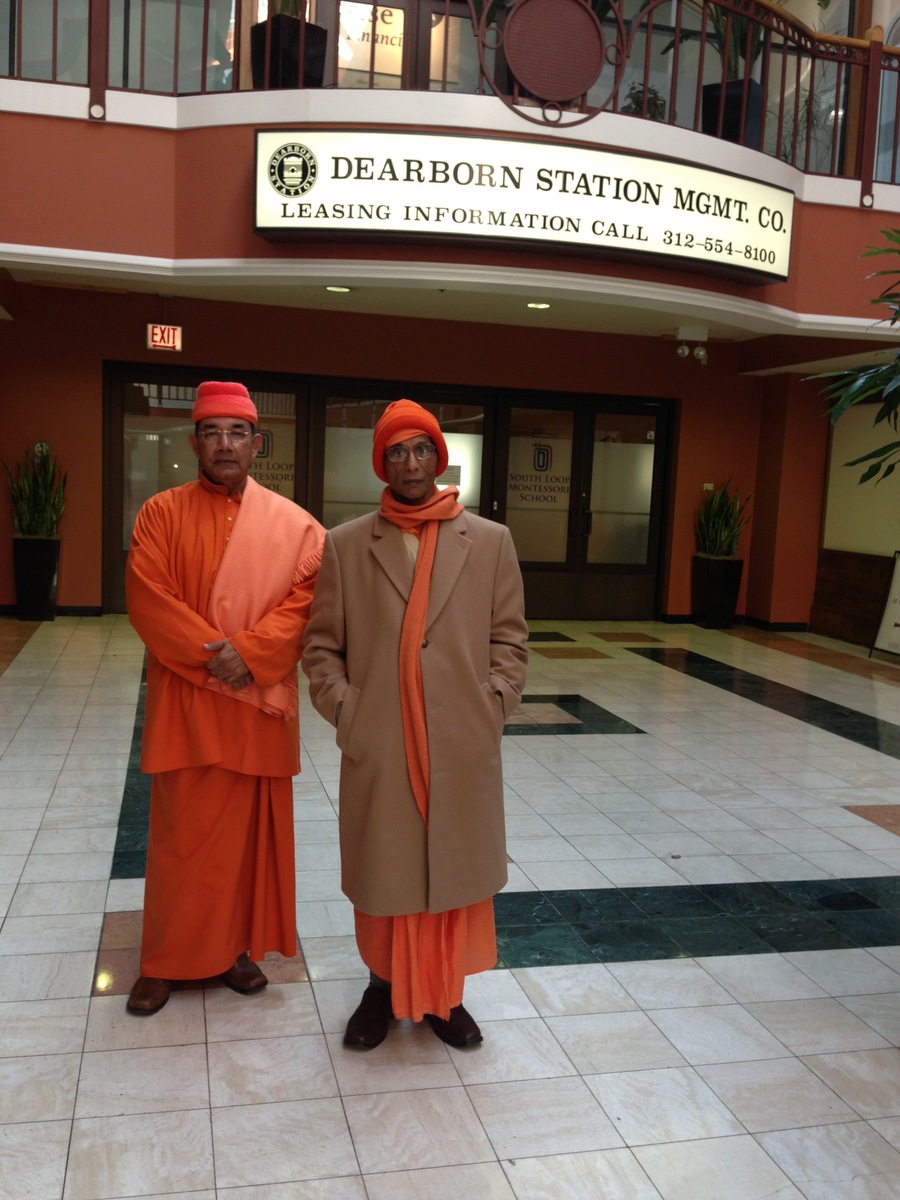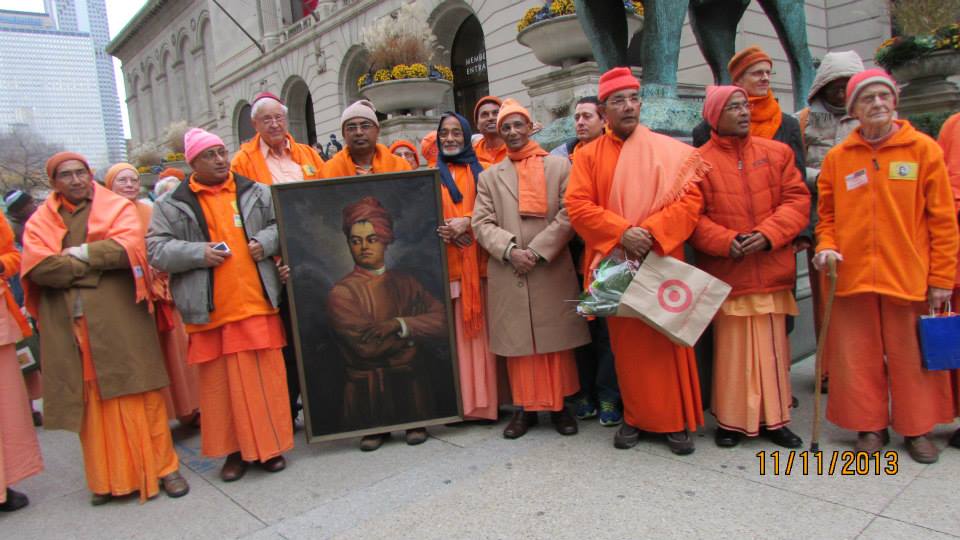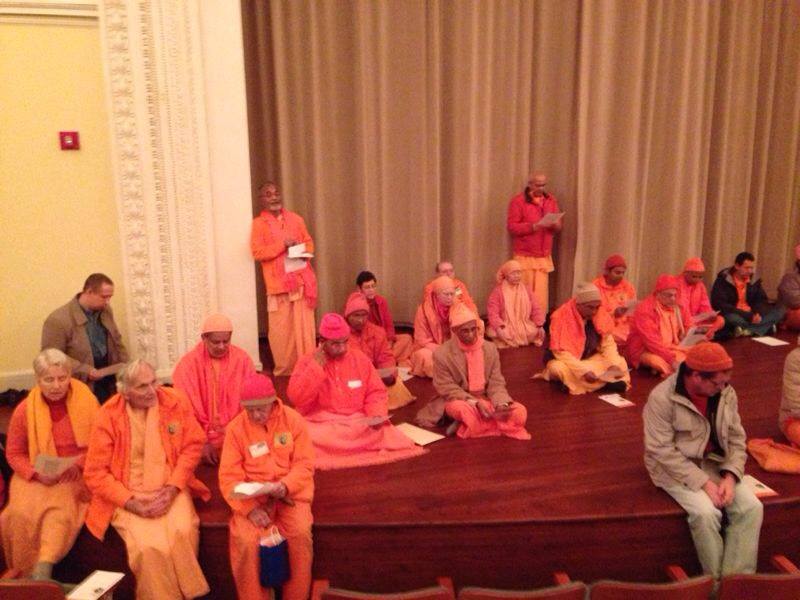Chicago Calling
Celebration of the 150th Birth Anniversary of Swami Vivekananda
by
The Vivekananda Vedanta Society of Chicago
Hundreds of eyebrows went up with curiosity when Swami Ishatmananda, the Minister-in-Charge of the Vivekananda Vedanta Society of Chicago in his welcome address to a gathering of more than 700 people assembled in the gorgeously decorated Grand Ballroom of the prestigious Hilton Hotel, downtown Chicago, said “Friends, we are here but a little late by 120 years.” Applause greeted the following words of his, “Had we been here before 120 years, we could meet Swami Vivekananda on this spot because this was the place where Vivekananda stayed for about a couple of weeks as a guest of Mr. and Mrs. Lyon during the Parliament of World’s Religions in 1893.”
The grand five-day long function, organized by the Vivekananda Vedanta Society of Chicago (VVSC) to celebrate the 150th birth anniversary of Swami Vivekananda began at Ganges, Michigan, an excellent retreat center situated on 110 acres of wooded lands with many cottages to accommodate 100 people. In 1847, Ganges village received its name from Dr. Joseph Coates, member of the Michigan legislature, after the holy river in India. In 1967 the third President of VVSC, Swami Bhashyananda, purchased the land and built the Vivekananda Monastery and Retreat.
Nearly fifty monastics arrived from around the world at the Vivekananda Monastery in Ganges, Michigan, in the early sunny afternoon of November 7, 2013, to render obeisance to their Founder-Swami on his 150th birth anniversary. Monks and devotees coming from such diverse places as India, Sri Lanka, Nepal, Germany, Switzerland, Moscow, Brazil, Argentina, South Africa, Japan, Canada, Fiji, and the different states of USA were received by volunteers and devotees of the VVSC.
The evening began with a special vesper service conducted by Swamis Kripamayananda from Toronto, Mahayogananda from Hollywood, and Tyagananda from Boston. It was followed by devotional singing by the monks and concluded with spectacular fireworks lighting up the night sky.
The following day (Nov 8) began with early morning vespers and chants and proceeded with a homa fire and special worship of Sri Ramakrishna by Swami Mahayogananda. Throughout the worship the attendees were held enthralled by the singing and chanting of devotees from Japan, South Africa, and Argentina in their native languages. At the same time, the monastics, including over a dozen nuns (pravrajikas), were participating in two conclaves: one for the heads of centers on the “Problems and the Prospects of Vedanta Movement outside India”, and the other, which included all the monks and nuns on the “Duties and Responsibilities of Ramakrishna Mission Monastics.” The “International Ramakrishna Mission Monastic Conferences” were presided over by Swami Suhitananda, the Administrative Head of the Order.
“God can be realized through all paths. All religions are true. Different creeds are but different paths to reach the same God.” These words of Sri Ramakrishna, the great saint of the 19th century and the master of Swami Vivekananda, capture the essence of the “Shrine Trail” which Swami Suhitananda inaugurated. A one-mile walk through the woods, the trail takes one past shrines dedicated to each of the major religions of the world – Buddhism, Christianity, Hinduism, Islam, Judaism, Jainism, Shintoism, and the “Panchavati”, the place in India where Sri Ramakrishna did his unique austerities and declared – “As many Faiths, so many Paths”. Earlier, 150 balloons were floated up to commemorate the 150th anniversary.
After the inauguration of the Shrine Trail and Sadhu Bhandara, the monastics along with the devotees left for Chicago where they were received by the Hindu Temple of Greater Chicago. They disembarked before the giant statue of their Founder-Swami, which they venerated and circumambulated before granting a brief audience to the awaiting devotees at the adjacent meditation center named after him. The packed Rathi auditorium within the main temple complex was then treated to the unprecedented sight, as the curtain was raised, of the seated monastics arrayed across three tiers of the grand stage as cameras kept flashing furiously. Six representative speeches, by way of greetings, were followed by a cultural program and dinner.
The main program at the auditorium began with an invocation of Lord Ganesha and a Tulsidas bhajan on Lord Rama. Prayers offered by the temple priests were followed by welcome speeches from the past president of the HTGC Bhima Reddy and the current president Tilak Marwaha. Sanskrit prayers to Sri Ramakrishna, Swami Vivekananda, and Ganesha followed the lighting of the auspicious lamp.
The Minister-in-Charge of VVS Chicago, Swami Ishatmananda, applauded the “nice scene on stage” comprising “nice people, who have renounced all to serve the world.” He enumerated their often far-away places of origin. Swami Tyagananda from Boston, who is chaplain at Harvard and MIT, emphasized the need for external festivities to be also celebrated internally if they were to be long-lived. We should take up at least one teaching of Vivekananda and put it to actual use, a prescription that he illustrated the next day in his talk on the quality of strength.
American convert, Swami Atmajnananda from Hollywood, recounted how, as a student of Western and Indian philosophy, he found what he was looking for when he picked up the Gita and then a small book for five rupees on The Teachings of Vivekananda. Staying with a family in Kolkata, he had walked barefoot in the scorching heat to Belur Math and was overwhelmed by the Dakshineshwar Kali temple and Sri Ramakrishna's room. Born of a Lutheran mother and Baptist father, who were already adrift from their religious moorings, Pravrajika Vajraprana explained how they came to Vedanta around the same time: “This country is built around the idea of freedom so central to Swami Vivekananda's teaching.”
Swami Nirmalatmananda from Sao Paulo spoke of Argentina and especially Brazil. “People are looking for something more despite 500 years of Christianity and language barriers.” Vivekananda left a mold to develop one's spiritual potential and translate it into service to humanity. He urged people to be strong; be rational and scientific and yet have sympathy for all forms of worship; learn to be calm and quiet inwardly even while engaged in intense external activity; and make spirituality a cheerful pursuit.
Swami Baneshananda from Germany emphasized the principle of harmony through mutual acceptance, illustrated by the ancient Hindu custom of family altars exhibiting multiple deities and each member practicing the religion in his or her own way. He criticized a Hindu leader's recent speech advocating the uniformization of beliefs and practices. The General Secretary of Ramakrishna Mission, Swami Suhitanandaji, was touched by the selflessness of all present: “the great man is he who sacrifices the most, and India's death will be the death of world spirituality.” He cited Sister Nivedita's statement that Hinduism was born with Vivekananda’s defense at the World Parliament of Religions. He praised the HTGC for including the statue of Vivekananda within its traditional pantheon.
Devotees, who had accompanied the monastics from faraway lands, were invited to file before them across the stage and were appreciatively captured on film to mark this historic occasion. They were followed by dedicated temple volunteers who had made this evening possible.
The hundreds of devotees from across the world had been accommodated in four hotels in Chicagoland and gathered at the Hilton on the morning of November 9th for the “International Vedanta Devotees Conference”.
The program was inaugurated by Swami Suhitananda, the General Secretary of the Ramakrishna Order, by the lighting of 150 lamps. The global nature of the gathering was echoed in the message from the Governor of Illinois, Pat Quinn, who asked everyone to “remember Swami Vivekananda’s philosophy of a world without borders.”
The day was filled with addresses by monks and nuns of the Ramakrishna Order on various aspects of Swami Vivekananda and his message. “A many-faceted personality who brought a new dimension to spirituality”, said Swami Suhitananda. Describing Chicago as “a very, very holy place”, Swami Chetanananda, a senior monk of the order and head of the Vedanta Society of St. Louis, in his talk “The Transformation from Narendranath to Vivekananda”, recollected how the non-dualistic experience and teachings of Sri Ramakrishna had transformed Narendranath Dutta into Swami Vivekananda. How dear and blessed Chicago is, was brought out by Swami Shantarupananda of Portland during his talk on “Vivekananda’s Contribution to Humanity”. He said, “As Buddha selected Sarnath for his message, as Jesus Christ selected the Mount [Sinai], Vivekananda selected Chicago to preach his message… the message of Freedom.” Swami Yogatmananda from Providence, in his talk, “Role of Swami Vivekananda in Redefining Hinduism and its Impact,” pointed out that Swami Vivekananda’s appearance at the Parliament of World’s Religions at Chicago in 1893 was a “turning point” and how Vivekananda brought the “ancient message in a new language.” Swami Yuktatmananda from the Ramakrishna Vivekananda Center in New York, while speaking on, “Swami Vivekananda: A bridge between the East and the West” mentioned that, “western science and eastern spirituality should go together” and that Vivekananda “brought the timeless wisdom of Vedanta to the West.” Swami Vivekananda’s addresses in Chicago “helped India, as well, because India was a subjugated nation at that time” said Swami Amarananda from Switzerland in his talk on “Swami Vivekananda’s contribution to the East” in particular.
Two monks, Swamis Mahayogananda and Harinamananda from Hollywood, introduced the speakers with brief biographical outlines and emceed the program. Interspersed between the talks were various musical performances – devotional and classical singing by Moumita Chatterjee, Radhika Bhalerao, Pritam Bhattacharjee, instrumental music by Prithwiraj Bhattacharjee, and a performance of Indian Fusion music by the South Asian Ensemble of the University of Chicago. Devotional songs by Swami Shubhakarananda of Belur Math and Swami Gaurangananda, head of Ramakrishna Mission of Nepal especially touched the hearts of the devotees.
“What I want are muscles of iron and nerves of steel,” quoted Swami Tyagananda of Boston in his address “Swami Vivekananda's Perspective on Strength”. He remarked how Vivekananda’s teachings are “a spiritual manual that point us to the different sources of strength and how to cultivate that strength.” Swami Ishtananda of Florida in speaking on “Swami Vivekananda: Manifestation of Concentration” spoke of Vivekananda’s power of control and concentration. Swami Nirmalatmananda of Brazil, in speaking on, “Swami Vivekananda: The Embodiment of Knowledge”, said that “Self-knowledge puts an end to suffering once and for all, removes all fears, and puts an end to all doubts.” Pravrajika Brahmaprana of Hollywood talked on ““Swami Vivekananda: The Embodiment of Devotion” and especially mentioned Swami Vivekananda’s “heart was so vast that it embraced all of humanity”. Swami Sarvarupananda from Sri Lanka spoke on “Swami Vivekananda: The Embodiment of Selfless Action” and pointed out Swamiji’s compassion and how he “felt for the people.”
The range of subjects addressed by the speakers amplified the universality of Swami Vivekananda’s message. Vivekananda is “universal because he looked at problems from the point of view of the whole of humanity” said Swami Baneshananda from Germany while speaking on “The Universal Vivekananda”. “Holistic, pluralistic, and all-inclusive” said Swami Medhasananda from Japan to describe “Swami Vivekananda's Concept of a Perfect Man”.
To answer the question, “Vivekananda’s philosophy and what we need to do to implement it?” Swami Tattwamayananda from San Francisco said Swami Vivekananda “offers a new religious concept that goes beyond accepted conventional definitions”. To solve the conflicts among the religious groups Swami Sarvadevananda head of the Vedanta Society of Southern California while speaking on “Swami Vivekananda’s contribution to Spiritual Unity in Diversity” said, “Swami Vivekananda’s mission was to lead us to spiritual unity. Spiritually we are all connected together”. Swami Kripamayananda of Toronto, Canada recalled, “A Few Blessed Americans who Helped Vivekananda”, the contributions of Prof. Wright of Harvard, Mrs. Hale of Chicago and Sister Christine.
The day concluded with the Presidential Address by Swami Suhitananda, the General Secretary of the Ramakrishna Order. His address echoed the special place Chicago holds to admirers and followers of Vivekananda. “The name Chicago and Swami Vivekananda have become synonymous for the Indians, and all those who have come in touch with Swami Vivekananda feel a thrill the moment they hear the name Chicago.” The audience burst into applause when he said, “the support for this program shows how the people of Chicago are also enthralled with Swami Vivekananda.” He mentioned Vivekananda’s admiration for the American spirit and quoted, “The Yankees - they can do anything and everything.” Devotees left the program hall singing the song, “Ramakrishna Sharanam” led by Swami Ishatmananda.
On the 10th of November, VVS Chicago Minister-in-Charge and Convener, Swami Ishatmananda, read out the blessings of Swami Atmasthananda, President, Ramakrishna Math and Mission, where he emphasized the contemporary universality of India's ancient teachings, Veadnata. He wrote, “I extend my warm greetings to the assembled monks, nuns, devotees, and the organizers of the celebrations and hope that the celebrations will help the Chicago Community to imbibe the spirit of Swami Vivekananda.”
The day-long proceedings were emceed by Octavia Harriston, an African-American VVSC devotee since the early 70s. Conveying the best wishes of Ma Amritanandamayi, Swami Dayamrita, a monastic of her ashrama read, “Vivekananda was a perfect blend of mental purity and vitality”. She quoted Vivekananda, “Take up one idea, make that one idea your life, think of it, dream of it, live on that idea...” A message of felicitation from the Archbishop of Chicago Francis Cardinal George, read out by his Vicar for Ecumenical and Religious Affairs, Father Thomas Baima, recalled that the 1993 World Parliament of Religions (WPR) declared the US to be a multi-religious and no longer just a Protestant-Catholic-Jewish society.
Author and researcher, Asim Chaudhuri, delivered the keynote address on "Vivekananda: Who he was, why and how he attended the WPR in Chicago." With his PowerPoint presentation he explained Vivekananda’s two-prong mission in America, 1) to improve the material condition of the Indian masses through financial help from the West, mainly America and 2) to interpret India’s spiritual culture, especially in its Vedantic setting.
Speaking on "Vivekananda's Contribution to the West," American convert, Swami Atmajnananda, noted that “we are just beginning to understand his true significance.” He informed that in 1976, during the US Bicentennial, the Smithsonian Institute brought out the book, “Abroad in America”, listing Swami Vivekananda among the 27 most important visitors to this country. Starting with his impact on philanthropist Rockefeller, Atmajnananda attempted to discern his influence on philosophers such as William James and Josiah Royce, and scientists like Nikola Tesla. He also cited an incident where Vivekananda identified himself with African-Americans despite being the object of mistaken discrimination. Vivekananda also supported the rights of women and they in turn stuck with him even though warned against “the heathen” by their preachers. “What he did in India also had a great influence on America for he encouraged his countrymen to become global in vision and action,” as is plainly visible in Chicago today.
In the beginning of the program of the 10th, Swami Ishatmananda explained why the celebration is named, “Chicago Calling”; on 27nd September of 1893, on the last day of the Parliament of Religions, Swami Vivekananda standing on the soil of Chicago gave a call to the humanity, “Help and not Fight”, “Assimilation and not Destruction”, “Harmony and Peace and not Dissension”. To remind the present day world about this call, the celebration was named “Chicago Calling”.
On the occasion of the 120th anniversary of World’s Parliament of Religions, a special panel, "Help, Assimilation, and Harmony" from the points of view of different world religions was convened. Four of the speakers were current or past Trustees of the Council for the World Parliament of Religions: Abdul Malik Mujahid (Islam), Rabbi Michael Balinsky (Judaism), Rev. Dr. Shanta D. Premawardhane (Protestantism), and Rohinton Rivetna (Zoroastrianism)
Rev. Donald Senior, C.P, President of the Council of Religious Leaders of Metropolitan Chicago, spoke on the willingness of the Catholic Church to validate those truths found in other religions that do not contradict its own tenets. Imam Mujahid began by observing that Vivekananda had been the talk of the town and nation, whereas other speakers at the WPR were discussed only in books dedicated to them. Mujahid noted that people of his faith were the first to respond to the 2004 tsunami [without discrimination].Rivetna fleshed out the mention in Vivekananda’s historic WPR speech of his persecuted Zoroastrian diaspora having found early refuge in India and clarified some of its basic tenets. Looking around at the ochre-robed monks, Premawardhana declared that “forced poverty is what we have to fight against, whereas voluntary poverty is what religious people have to embrace.” He emphasized the power of organized religion to effectuate socio-political change. Religious organizations should “do all things together, except when deep differences of convictions oblige us to work separately," the Protestant representative said. Hema Pokharna spoke of Mahavira's life, teaching, and respect for even non-human life as exemplary, and mentioned Veerchand Gandhi, who represented Jainism at WPR. Jains do not see anyone as an enemy and Jina means "spiritual conqueror."
How to relate constructively to other religious traditions despite exclusive and conflicting truth claims has remained a central concern of Judaism, said Rabbi Balinsky: “How to look at another religion from within one's own tradition? Does God protect only Israel and not other nations?” he asked, citing a 3rd century rabbinical commentary on a biblical passage posing this very question. Instead of a hermeneutics of suspicion we need one of compassion. At the same time, Balinski warned of the danger of collapsing borders between (particularistic) religious traditions.
American convert nun Pravrajika Saradeshaprana’s speech on, "Why Swami Vivekananda is Relevant Today?" focused on the needy men and women in contemporary America. We internalize the limitations projected upon us by others, as exemplified by the 30% of women across all faith communities, who suffer domestic violence and psychological abuse, and thus end up believing themselves unworthy of love. Such self-defeating attitudes and behaviors are transmitted down generationally. The antidote to this is Vivekananda’s insistence on our inherent worth and the power of self-transformation. Vivekananda experienced hunger, rejection, unemployment, immigration, racism, and bigotry at first hand. Generosity, according to his vision, should be three-tiered, comprising food, education (especially for women), and spiritual teaching. Vivekananda democratized Hinduism, opening it up to men and women of all religions, into an export religion.
Consul General of India to Chicago, Dr. Ausaf Sayeed, declared that there is no place like India for unity-in-diversity as made evident through his extensive travels across the subcontinent. He contrasted this to the interdenominational violence witnessed during his stint as ambassador to Yemen, where a peaceful gathering of religious scholars was attacked by an opposing sect.
The retrospectives on the Vedanta Movement in Fiji, Russia, and the United States was discussed. Swami Aparokshananda from Fiji recounted how Kuppuswami, a devotee of Sri Ramakrishna, formed an association on the latter's birthday to protect the rights of indentured Indian laborers that subsequently became the nucleus of the Ramakrishna Movement there. Levels of poverty have increased in the island after the exodus of business classes and skilled workers providing much scope for social work. Russian-born and Moscow-based Swami Vidishananda said there had been no room for religion for 70 years under the post-Oct 17 Revolution state ideology of dialectical materialism and subsequent nationalist proclivities. The Vedanta movement began barely 20 years ago; the Society registered only in 1995. Romain Rolland's 1936 volume on Ramakrishna and Vivekananda was not published in Russia till 1991 but attracted much interest thereafter. Swami Ranganathananda was invited by Soviet scholars to lecture in Moscow and Leningrad in 1961, but restrictions are still imposed on “non-traditional” religions. The originally independent St. Petersburg center was inspired in late 1990 by the visit of Swami Lokeswarananda, the then the Secretary of Ramakrishna Mission Institute of Culture, Kolkata. The Moscow center was established the following year, at the invitation of the Soviet Academy of Sciences, by Swami Jyotirupananda, who heads both centers and has spread the Vedanta movement in Russia since 1991, renewing the interest in Indian spirituality that had been awakened at the turn of the 19th century by the WPR.
Speaking on "Vedanta Movement in America," Dr. Hal French observed that this was the “Year of India” in many ways. [US-wide celebrations of 150th Birth Anniversary of Swami Vivekananda, announcement of Vivekananda Chair at the University of Chicago, publication of encyclopedia of Hinduism by the University of South Carolina.] Swami Vivekananda's three gifts, according to Hal French, were his high evaluation of Man, Freedom, and mutual respect and harmony among Faiths that underlies today’s courses in comparative religion.
There was also a panel on "Help, Assimilation, and Harmony” from intra-Hindu points of view. Swami Prapannananda of Sacramento spoke on Vaishnavism, and how some of its themes and qualities are reflected in Vivekananda's teachings. He dealt on the songs of Chaitanya Mahaprabhu, Narsi Mehta's "Vaishnava Jana" and Tulsidas' Ram Dhun. Swami Shantarupananda explained Tantra, which he called the “most neglected branch of Indian religions” to the uninitiated. Tantra accepts the “power of consciousness” (cit-shakti). He distinguished three paths based on differing tendencies within Tantra itself: the “animal” (pashu-bhava) transgressively exploiting the five M’s but with a view towards transcendence, the “heroic” (veera-bhava) and the “divine” (divya-bhava) practiced by Sri Ramakrishna, culminating in insight into the unity of religions. He concluded quoting Sri Ramakrishna that “accomplished Vaishnavas do not condemn Shakti”.
Speaking on Vedanta, which talks about freedom and democracy, Swami Chetanananda noted that the addresses of Vivekananda based on core teachings of Vedanta, shook Indians out of their sense of inferiority. His great gift to the world was the (formulation of the) four yogas, divinity of man, unity of all things, and harmony of religions. The four sources of the latter are the scriptures, the experience of his guru Ramakrishna, the internal diversity of Hinduism, and his own experience. India has helped other religions by offering refuge to the persecuted from other nations because of the broadness of Vedantic philosophy. America is the best place to teach Vedanta because of its attachment to freedom and democracy.
The General Secretary of the Ramakrishna Mission, Swami Suhitanandaji’s discourse was titled "For One's Own Liberation and the Welfare of the World." He described the progression of human desire from the survival instinct, through hedonism and the desire for recognition, to hunger for knowledge and quest for liberation. Capitalism cannot survive in its current form but has to go beyond economics and take subtler dimensions (psychology) of human existence into account. The approach must now be international and start from the mental (as opposed to physical) plane, insisting on truth-speaking, mastery of the senses, and helping others. He reiterated Ma Amritanandamayi’s suggestion at the opening benedictory session that India should impose a program of selfless service for graduates. Recalling Vivekananda’s love for, and admiration of, America, he quoted, "They loved me, and I also loved them.” He then cited Indian Prime Minister Manmohan Singh who has characterized Vivekananda as the "tallest figure of his age who had transformed history."
Between the panels were appropriate musical interludes. Sacred Waters Kirtan Group from South Bend, Indiana, performed American-style bhajans. Ranajay sang a devotional song, as did Sampa and Supriya of the Chicago Bengali Society. Lajja and Tulsi performed the “dance of bliss” (anandatandava). Swami Pareshananda, head of the Ramakrishna Ashrama, Argentina recited an English poem and chanted a Spanish hymn for Vivekananda.
In honor of the celebration of Swami Vivekananda’s 150th birth anniversary, the Vivekananda Vedanta Society of Chicago has published a book, entitled, “Chicago and Vivekananda”, which was released by Swami Suhitananda, the general secretary of the Ramakrishna Math & Mission. The book contains detailed information on places and people of Chicago associated with Swami Vivekananda.
After the vote of thanks, Swami Ishatmananda requested each and every one to join to serve the “living gods” of Swami Vivekananda – the poor, the downtrodden, the illiterate and the oppressed of all races and countries. “Please contact us at [email protected] if you like to participate in the worship if the Divine in the human form” he said. The commemorations concluded with a congregational closing song "Get up O my Brethren... see Swamiji by your side" led by Swami Ishatmananda. The next morning the visiting monastics were bused to Chicago for a tour of various sites associated with Swami Vivekananda. Sitting on the wooden platform of the hall where Swami Vivekananda delivered his historic “Chicago Addresses” in 1893 the monastics prayed and meditated before bidding farewell to Chicago after answering his “Call”.
